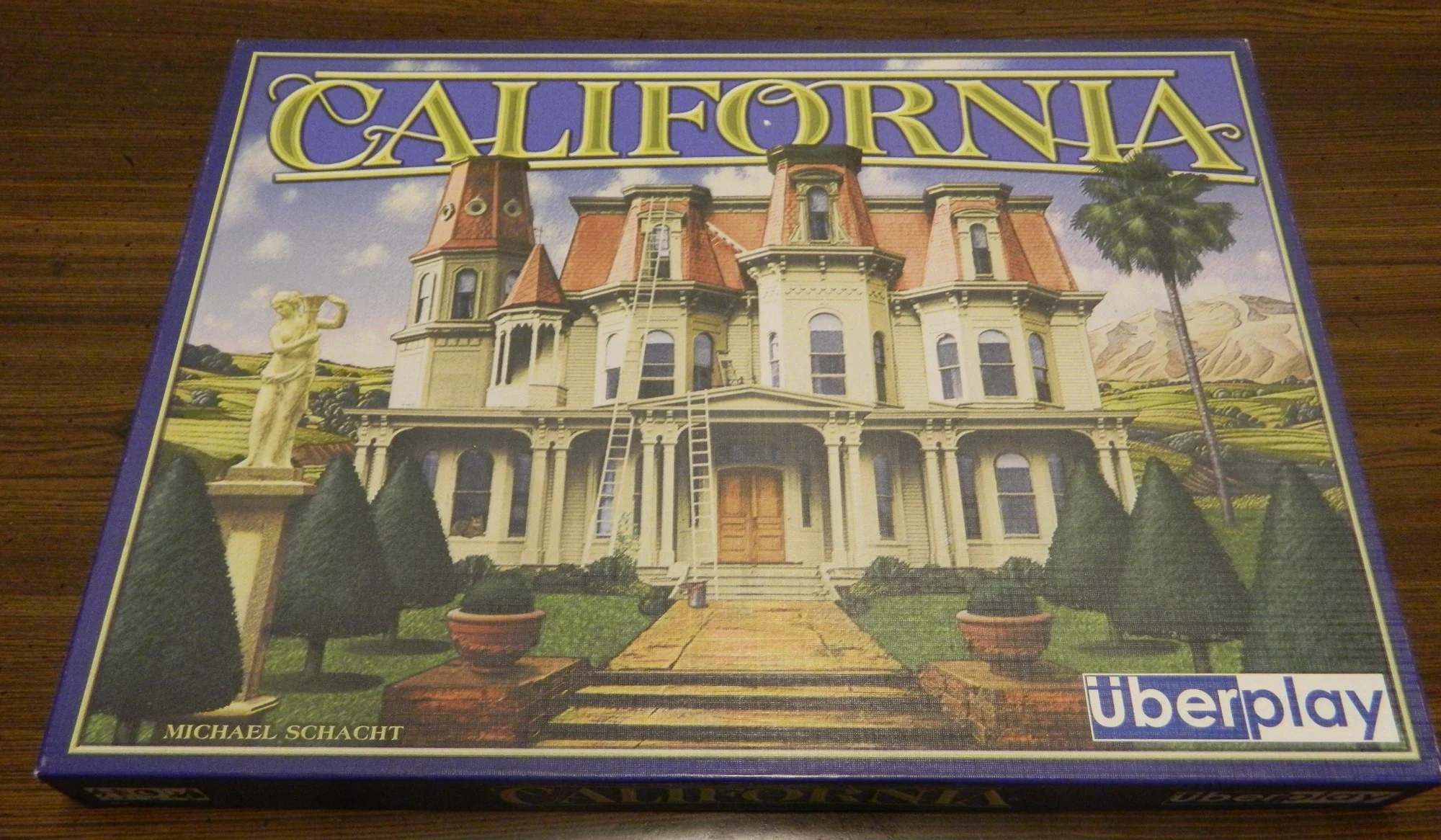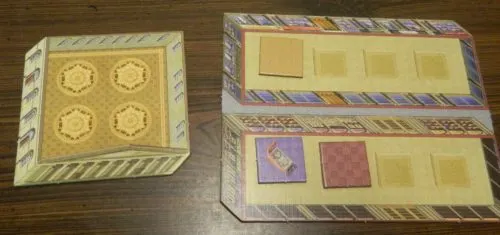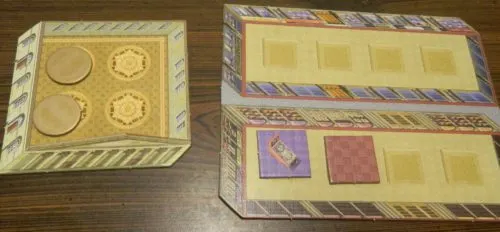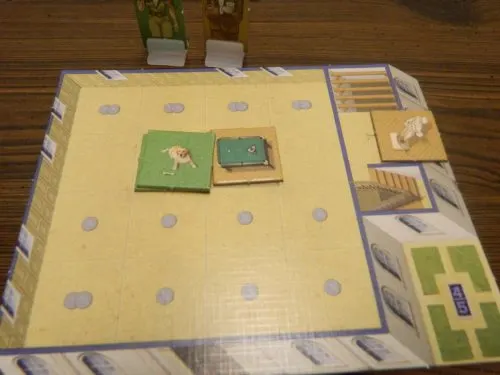How to Play
Setup
- Mix up the tiles and form a face down stack in the middle of the table.
- Place the bonus cards, coins, loan markers, gifts, bank board and store board on the table where everyone can reach them. Separate the coins into gold (worth five) and silver (worth one) piles.
- Give each player one silver coin, one gold coin, and one mansion board. Place the side of the mansion board face up that corresponds to the number of players playing the game.
- Decide which player will start the game.
Playing the Game
In California players take turns and can do one of the following actions:
- Take one gold coin from the bank.
- Buy a tile from the store and put it into their mansion.
Play then passes to the next player in a clockwise manner.
California is played in twelve different rounds. At the beginning of each round a gold coin is placed on each space in the bank and a tile is placed on each space of both shops. A round continues until one of the following occur:
- All of the coins have been taken from the bank
- All of the tiles have been taken from one of the stores.
When a round ends all of the tiles left in the stores are removed from the game. The stores and bank are refilled with new tiles/coins. After the 11th day the store is refilled with the tiles not purchased on the other days.
Buying and Placing Tiles
If a player chooses to buy a tile they pay the bank an amount equal to the number of coins currently in the bank. For example if there are two coins in the bank, buying a tile will cost two silver coins.
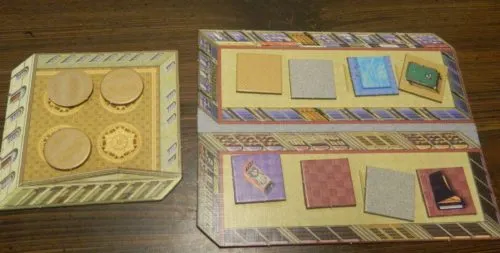
Since there are three coins in the bank, it will cost three silver coins to buy a tile from the store.
The player then chooses one tile from one of the two stores. You can buy only one tile on your turn. A tile that is purchased has to immediately be placed into the player’s mansion. There are three different types of tiles that a player can purchase from the store:
Renovated Rooms: A majority of the tiles for sale are renovated room tiles. When purchased these tiles must be placed in an empty space in your mansion. Each floor space can only have one renovated room tile and once a renovated room tile is placed it cannot be removed.
There are a couple rules regarding placing renovated room tiles:
- All renovated room tiles of the same color must be placed next to one another (not diagonally).
- If a renovated room tile is placed on a floor space that has coins printed on it, the player must pay the associated amount of coins to place the tile.
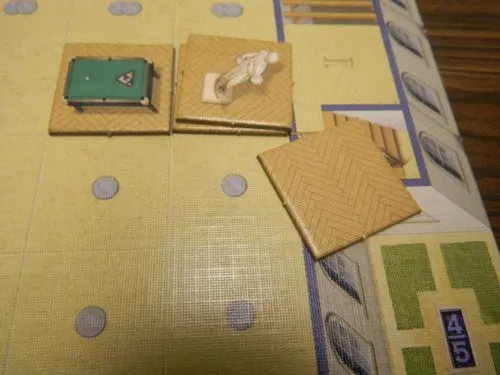
This player has purchased a tan colored tile. They must place it next to the other two tan colored tiles already in their mansion. To place it on one of the spaces below the tiles already in their mansion they will have to pay one coin. Otherwise they will have to pay two coins to play it on a space above the two tiles already placed.
Furniture Tiles: Furniture Tiles feature various pieces of furniture and a colored floor. Furniture tiles may only be placed on renovated room tiles of the same color. Only one furniture tile may be played on each renovated room tile. If a player purchases a furniture tile that they don’t have an associated free renovated room tile for, the player needs to put the furniture in the attic.
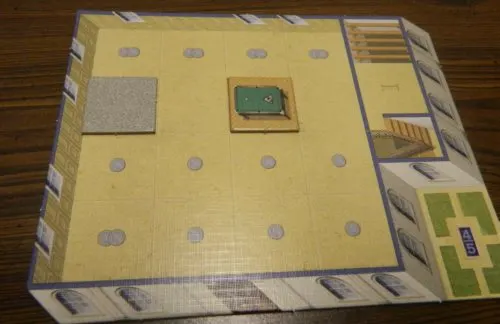
The player has acquired a pool table so they place it on the tan colored tile already in their mansion.
The Attic: There are a couple tiles that a player can buy that can expand a player’s attic. To start the game each player can only store one piece of furniture in their attic. A player can never store a renovated room tile in the attic.
If a player buys the attic tile they can expand their attic to store two pieces of furniture. Players can only expand their attic one time.
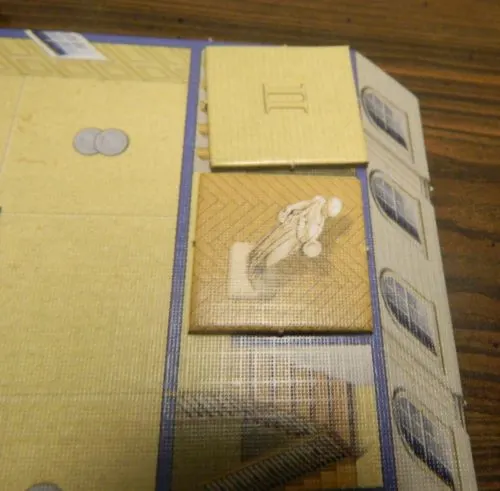
This player has bought the tile that expands their attic. They already have one item in the attic so they can add one more item to the attic.
When a player adds a renovated room tile to their mansion that matches one of the items they are storing in the attic, the item from the attic is immediately removed from the attic and placed onto the renovated room tile that was purchased.
Attracting Guests and Gifts
One of the goals in California is to attract guests to your house. Whenever a player adds a piece of furniture to one of their rooms they will attract a guest to their house. The guest of the corresponding color will leave whichever home they are currently in and travel to your house. When a new guest comes to your house they will bring along a gift if there is currently at least one other guest at your house. You take one of the gift tokens from the bank which are worth a point at the end of the game. If you add a piece of furniture of a guest that is already at your house, they do not bring a gift since they were already at your house.
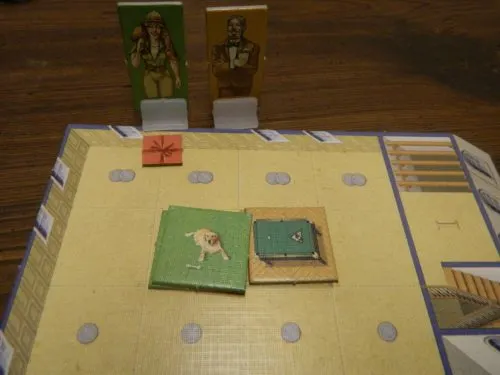
This player already had the tan guest in their mansion from when they played the pool table. When they added the dog to their house they attracted the green guest who brings along a gift.
Bonus Cards
While building your mansion, a player may fulfill the requirements of one of the bonus cards. The first player to furnish their mansion with the combination of furniture pictured on a bonus card gets to claim the card and gets the corresponding number of points at the end of the game. If the bonus card doesn’t picture a specific piece of furniture the player can use any type of furniture of the corresponding color. When placing furniture in your house, the furniture does not have to be placed in the same order as it is pictured on the bonus card. Furniture stored in the attic does not count towards collecting bonus cards.
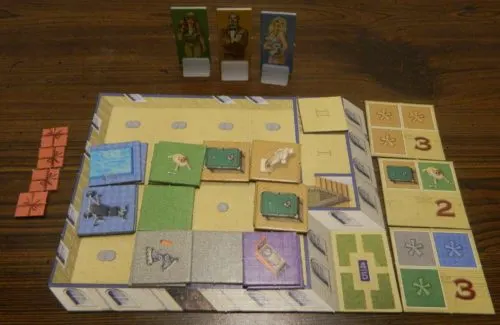
This player has acquired three bonus cards. The top card they got because they have three tan rooms with furniture in them. The middle bonus card they got because they have a dog and pool table in their mansion. Finally the last bonus card they got because they have one blue, grey, and green piece of furniture in their house.
Loans
If a player wants a loan they can take one out at any time. The player takes a loan token and takes three silver coins from the supply. A player can only have one loan outstanding at a time. When a player wants to pay back their loan (they can do this at any time) they have to pay four silver coins to the supply. The player then gets rid of the loan token.
End of Game
After the twelfth round the game ends. Players will calculate their scores as follows:
- 1 point for each gift collected during the game.
- Points equal to the numbers printed on any bonus cards collected.
- 1 point for each space of the mansion that has at least one tile on it. The space automatically filled in on each mansion card counts as being filled.
- -2 points if the player is unable to repay a loan.
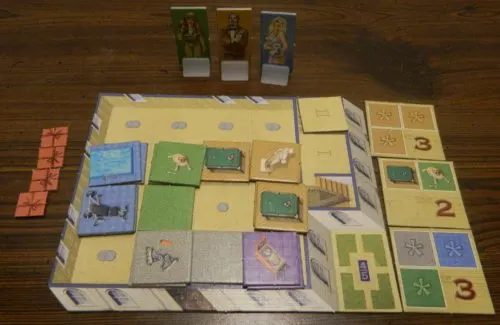
This player has scored points as follows: 4 points for the presents, 10 points for the spaces filled with at least one tile, and eight points for the bonus tiles for a total of 22 points.
Whichever player has the most points wins the game. If two or more players are tied, the player with the most money will break the tie.
Review
Generally I would say that I like all types of board games from light filler games to head scratching strategy games. Each extreme has its’ issues though. Light games generally don’t have a lot of strategy and rely too much on luck. Heavy strategy games tend to take too long and are hard to get into since there are so many rules. This is why one of my favorite types of games are the games that occupy the light to moderate strategy realm.
California is one of those light to moderate games. The game has a decent amount of mechanics but all of them are easy to learn. I would guess most players should be able to learn the game within five to ten minutes. The game also plays pretty quickly. The box has an estimated playtime of 60 minutes but I personally think it is not that long of game. Your first game may take an hour but I think the typical game would last closer to 30-45 minutes.
The main reason that I enjoyed California is that it is so easy to play but has plenty of decisions to make that actually impact the game. On your turn you only have two options: take money or buy a tile. I like the simplicity of only two actions but I like that both actions will help you. Some games make you either pass your turn or take an action that doesn’t really help you. In California you will always be able to take an action that will help you. While you only have two possible actions there are plenty of things to think about before choosing either of them.
Let’s start with the choice to take money. Sometimes this choice will be forced on you since you don’t have the money to buy a tile. Otherwise you have some things to think about before taking money. First by taking money you are lowering the cost to purchase tiles for all of the other players. You will benefit from the additional money but you are also helping all of the other players by making the tiles cheaper for them. Second if you take money you could end up losing out on the chance to buy a tile you really need. You may need to forgo the money to get the tile you really need. Finally you might not need the money but could decide to take it because you don’t need any of the tiles that are remaining and you want to end the round before one of the other players can get a tile they need.
Let’s move onto buying tiles. If you don’t have enough money you won’t be able to buy tiles so the decision could be made for you. If you have enough money to buy a tile there are plenty of things to consider. First you need to see if there are any tiles that you could actually use. When choosing which tiles to purchase you need to consider what bonus cards you can claim, what items you can currently place in your mansion and what items would attract additional guests to your home. There is also the possibility of buying a tile just so another player is unable to buy it if they really need it. You could also buy a tile that will end the round which will deny a player of getting another turn during the current round.
With just a decision between two actions the game gives you plenty of different things to think about before you make your decision. I was surprised by how much players can actually impact one another. While everyone is building their own mansions, your actions in the game will have an impact on the other players. You can mess with a player by stealing one of their guests which helps you and hurts them. You could also either purchase a tile another player desperately needs or you could end the round before they have an opportunity to purchase it. The game has a surprising amount of take that possibilities.
Speaking of impacting other players, this does present one issue that I have with the game. The game has a lot of luck which comes from turn order. The turn order of each round can become crucial in the game. When a new round begins the turn order has a big impact. If you have to play right away you have the benefit of getting first choice of tiles but you also have to pay the maximum amount. The first player in each round needs to decide if the tile they want is truly worth four silver coins. The opposite can also be true if you are one of the last people to play in a round. You could end up getting no chance to purchase the tiles you really need. Turn order is important enough that you need to factor in how your move will impact turn order for the next round. This is an interesting element of the game but at times it seems like the turn order has too big of an impact on the outcome of the game.
Another issue with the game is the fact that while you have quite a bit of impact on your fate in the game, luck still plays a big role. All of the tiles will eventually be put up for sale but the order in which the tiles come out can be really important. You could be specifically looking for a certain type of tile and it just doesn’t come up. This can ruin your strategy. Also the turn order could keep working against you whenever a tile you need actually comes up. Luck is not a huge factor in the game but sometimes players will win/lose the game due to luck.
In addition to its’ simplicity, another thing I like is that California has several different ways to score points which gives you options in how to play the game. You can get points by filling in parts of your mansion, completing goal cards, or attracting guests to your house. Attracting guests to your house is the least predictable since it depends the most on what other players do. It is an interesting idea though. You could end up scoring quite a few points if you can constantly attract new guests to your house. The safest way to score points is to fill in your mansion since the other players have no impact on how much of your mansion you fill in. I think the bonus cards are usually the deciding factor though. These cards can get you a lot of points quick but you have to compete with the other players to obtain them. You can somewhat tell what the other players are going after though so you could hedge your risk by going after goal cards that none of the other players are going after.
I would have to say that California’s greatest weakness is the simple fact that the game’s theme doesn’t make a lot of sense. I have to admit that I have never played a home decorating game before. While California is a good game, the theme feels pasted on. The game’s mechanics work quite well but it kind of seems like the designer came up with the mechanics first and then decided on a theme to use for the game. I feel this way due to some of the weird things that can occur in the game. For example you can attract a guest to your house with your new pool table or other piece of furniture and they just stay at your house for days until someone else gets a new piece of furniture. I really doubt any piece of furniture is so engaging that people will stay at a stranger’s house for days just to bask in its’ glory. You also can also encounter situations where you have to put your dog or pool into your attic since you don’t have the proper room/floor in the house yet. The theme is not terrible but these little snafus break the immersion of the theme.
Component wise I would say the game is pretty good for the most part. I like that all of the pieces are made of a pretty thick cardboard. The game also includes a lot of components. The components are well designed and do a good job aiding in making the game easy to play. My only real complaint with the components is that some of the artwork is kind of bland. Some of the artwork is not bad but a lot of it is just plain dull.
Final Verdict
California is an interesting little game. When you think of a game based on the interior decoration of a Californian mansion, you would think the game would be boring. While the theme is a little questionable, the game is actually quite fun. California is the type of game that I love because it is simple to play but still has plenty of strategy. You can learn the game in around 10 minutes and finish the game in around 30-60 minutes. With such simplicity it is refreshing that there is a surprising amount of strategy since your decisions will impact your fate in the game. California does have some situations where luck can ruin a player’s strategy but usually your actions will determine how well you do in the game.
If you only like moderate to heavy strategy games, California may not be for you. If the theme or the game’s mechanics don’t really interest you, California may not be for you either. If you are looking for a light to moderate strategy game that is simple to play and learn though I think California could be the game for you. As a bonus at the time of this review California is quite cheap so you can get a good deal on the game.
If you would like to purchase California you can purchase it on Amazon here.

